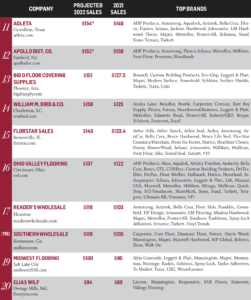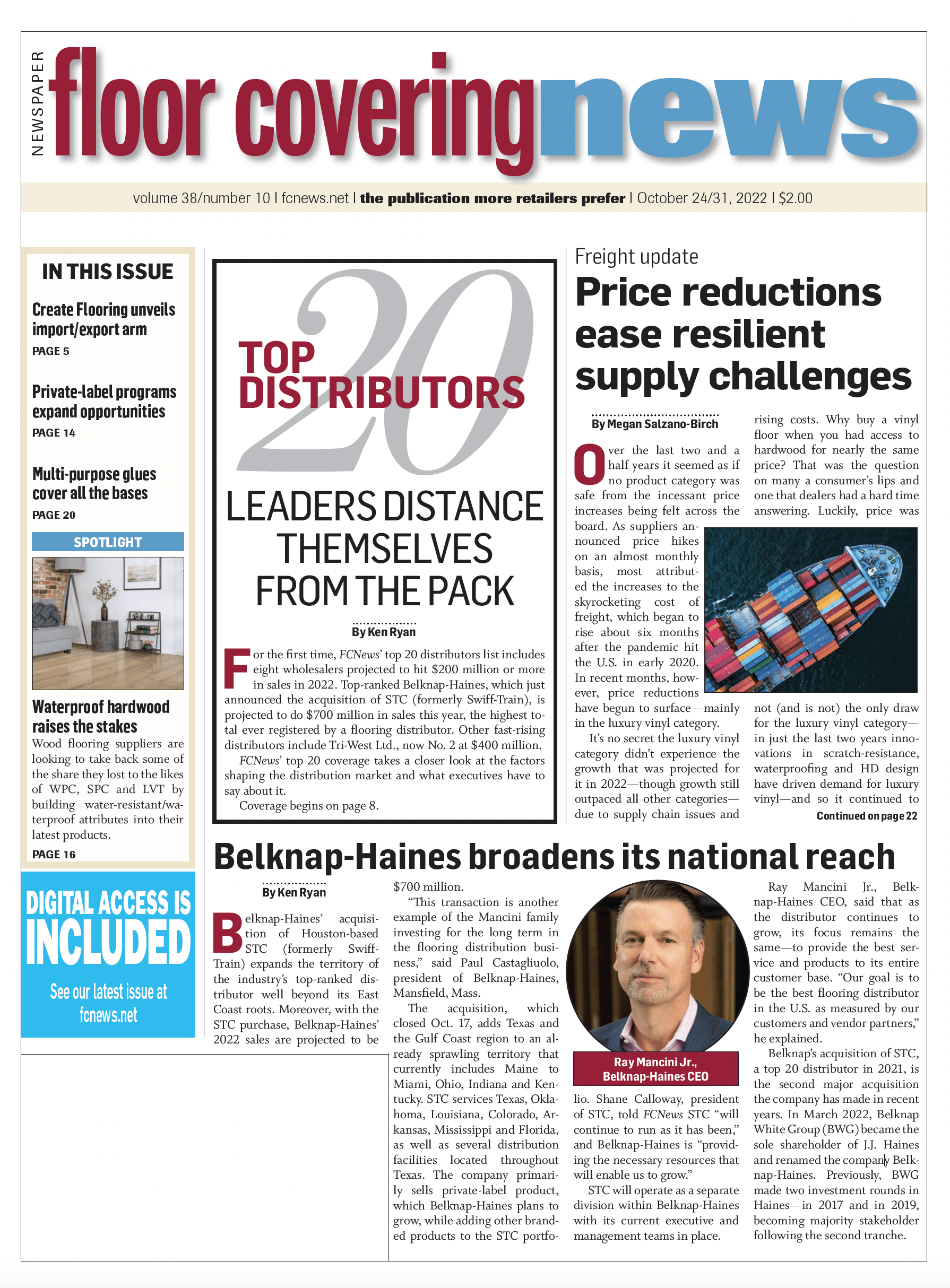 Following what for many was a record 2021, flooring distributors weren’t certain what to expect in 2022 given inflationary pressures, interest rate hikes and recessionary fears. But if the COVID-19 era has taught us anything it’s that nothing in business these days is normal, much less predictable. As it unfolded, the majority of FCNews’ Top 20 distributors are forecasting sales increases for 2022, including a few with double-digit jumps.
Following what for many was a record 2021, flooring distributors weren’t certain what to expect in 2022 given inflationary pressures, interest rate hikes and recessionary fears. But if the COVID-19 era has taught us anything it’s that nothing in business these days is normal, much less predictable. As it unfolded, the majority of FCNews’ Top 20 distributors are forecasting sales increases for 2022, including a few with double-digit jumps.
“Heading into COVID-19, no one would have told you that 2020 and 2021 would be two of the best years,” said Jeff Striegel, president of Elias Wilf, Owings Mills, Md. “This is the new normal. At the same time, it is unrealistic to expect this to continue.”
The upward trajectory comes with the caveat that while sales are up, unit volume is down by a greater percentage—an indication most of the growth is occurring organically. A case in point is Tri-West Ltd., now the No. 2 ranked distributor with projected 2022 sales of $400 million—up well over 20% from the previous year. “In our case, 100% of our growth has come organically,” said Dave White, president of the Santa Fe Springs, Calif.-based distributor. “Our geography covers over one-third of the U.S. The majority of our business is in Southern California and Northern California, but the Pacific Northwest market is doing very well for us, too. We expanded to Colorado six years ago and that has been going like crazy. It’s growth that is within our geography.”
White said the company continues to secure very large orders from customers who have money and are willing to spend it on home improvements.
Other distributors are seeing similar activity. “The main factors fueling business today have been demand across all segments and frankly all categories,” said Scott Rozmus, president/CEO of FlorStar Sales, Romeoville, Ill. “We have seen a softening as we’ve moved through the summer as inflation in both materials and freight costs have tempered demand. However, consumers are still out there spending money. We just need to work to help support our dealers’ efforts to encourage that spend to be within our industry.”
Although interest rates and material costs are up, several distributors say the builder/multi-family segment has been consistently strong in 2022 and should remain that way in 2023 despite its share of challenges. The commercial segment, which has lagged other flooring sectors, has been playing catch-up since 2020 and looks to be in growth mode in 2023.


Housing activity
The builder/multi-family channels truly represent a dichotomy. On one hand, the number of homes under construction rose to 1.67 million in May 2022, the highest in government data back to 1969. At the same time, record-level home price increases and rising interest rates in 2021-22 have created quite the chilling effect on both new home sales and cancellations. In fact, homebuilder cancellation rates have more than doubled since April 2022, according to data compiled by John Burns Real Estate Consulting, which reported that in July 17.6% of builder contracts fell through compared with 8% in April and 7.5% in July 2021.
Soaring mortgage rates coupled with persistent high selling prices are undercutting the overall housing market. The Commerce Dept. reported permits for future homebuilding plunged to levels last seen during the first wave of the COVID-19 pandemic in the spring of 2020. Homebuilding is also being hamstrung by still-ongoing supply chain bottlenecks, which continue to push prices for materials ever higher.
Some distributors fear that business activity might not be sustainable once builders get caught up on the record-level backlog. “What happens from here depends on the Fed’s ability to tame inflation and how quickly that occurs, and the concern here is always the same—is the cure worse than the disease?” Elias Wilf’s Striegel said, referring to interest rate hikes possibly pushing the country into recession. “The real question becomes just how far interest rates must increase to impact inflation rates in a meaningful way, and can they truly engineer the proverbial ‘soft-landing.’”
Recession or not, distributors point out that any comparisons between a potential dip in 2022-23 bears little resemblance to the Great Recession of more than a decade ago. Today, homeowners are better leveraged with cash than they were during the subprime mortgage crash that began in 2007, when home values plummeted by nearly half in some major markets. Millions of borrowers went underwater on their mortgages as a result. That is not the case today, experts say. Current borrowers, on average, owe just 42% of their home’s value on both first and second mortgages—the lowest leverage on record, Black Knight Data & Analytics reported.
The firm noted there are about 275,000 borrowers who would fall underwater if their homes were to lose 5% of their current value in today’s market. More than 80% of those borrowers purchased their homes in the first six months of this year, the peak of the market. However, even with a universal 15% decline in prices, negative equity rates would still be nowhere near the levels seen during the Great Recession.
Labor challenges
To varying degrees all flooring distributors are dealing with the labor shortage—a phenomenon for which there is no silver-bullet solution. According to the Bureau of Labor Statistics (BLS), there were roughly 500,000 job openings in the construction industry as of April 2022, compared with the previous high of 438,000 in April 2019.
What’s more, that need is unlikely to be met by a rapidly aging workforce. Since the end of the Great Recession, the share of construction workers aged 25-54 has dropped 8%, while the share of those 55 and over has risen, according to Associated Builders and Contractors. Statistics show 20% of today’s workers are 55 and older, with 61 the average retirement age—meaning a fifth of the industry is at risk of leaving within the next six years.
Distributors say they feel the pinch. “We’re constantly working to attract and retain personnel but so is everyone else, both inside and outside the industry,” Rozmus explained. “The challenge remains ongoing.”
To retain key employees, distributors have increased pay significantly in the last two years. “With labor costs up 10% to 15% on a comparative basis, we’re paying more to replace open positions and are increasing wages to retain key personnel,” said Paul Castagliuolo, president of Belknap-Haines, Mansfield, Mass., the industry’s No. 1 ranked distributor.
E.J. Welch & Company, Earth City, Mo., implemented a sign-on bonus and referral bonus to attract people, and both efforts have been effective in securing talent, according to Mitch Jolley, CEO. “We also outsource our search when needed and have seen most recently the applicant pool of qualified candidates has improved.”
In that same vein, NRF Distributors, based in Augusta, Maine, is routinely testing ways to attract and maintain competent and reliable staff. Incentives include generous sign-on bonuses, flexible work schedules and employee benefits.
Memphis, Tenn.-based BPI, meanwhile, handed out the largest aggregate raises in its history to strengthen its retention efforts, according to Wally McAlexander, COO.
Keeping outstanding personnel has been a catalyst in Galleher’s steady rise to top-five status in recent years. “We provide a great place to work, and this has helped us avoid significant turnover issues,” said Ted Kozikowski, CEO. “Where we do face shortages, such as with drivers and warehouse workers, we are making sure wages and other benefit programs are in line with local market and industry standards.”
Product trends
The LVT category, led by SPC/rigid core, continues to be the dominant product segment for many distributors, accounting for 30% or more of product mix for more than half the Top 20. However, the laminate flooring segment has made the greatest inroads year-over-year with wholesalers. Hardwood, by comparison, has maintained its cache despite ceding some ground to SPC/laminate.
“We’re seeing a resurgence in laminate,” Tri-West’s White said. “Laminate is being preferred by many retailers as there is a lot of [low-end] SPC coming into the market.”
For the first time in a decade, Elias Wilf’s percentage of waterproof resilient sales has declined—by 2%, due largely to multiple price increases that enabled laminate to seize an opening. “Laminate has exploded this year and builder is clearly lit up about laminate,” Striegel said. “When LVT stopped being an alternative to high-priced wood, laminate filled that void.”
Still, Striegel said he is not ready to write the obituary for the waterproof resilient segment—far from it. As he explained, “Freight issues are subsiding and as it does LVT pricing will drop faster than laminate. And above all the rest, LVT is used in every channel whereas with laminate you wouldn’t want to use it in commercial. LVT, however, has universal acceptance. It’s amazing how much multi-family was 3/8-inch hardwood five years ago and today that business is almost all SPC and its various cousins. I don’t think anything can stop its accelerated growth. SPC is a beast.”

